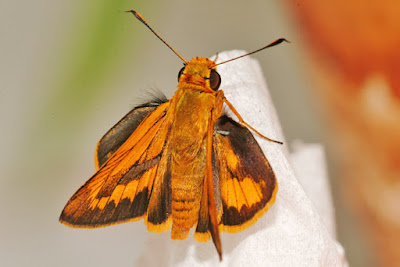The Telicota sp. was bred many years back but unable to ID with confidence, as there's no clear photo of Telicota augias showing the upperside especially the male stigma in reference books as well as online resources.
Using the deduction method, it was then decided the skipper is Telicota augias.
List of Telicota species compared:
T. ohara - male genitalia & stigma not matched
T. besta - male genitalia & stigma not matched
T. colon - male genitalia closely resembled, stigma not matched, yellow band not extended
T. ohara - male genitalia & stigma not matched
T. linna - male genitalia not matched
T. hilda - this species have underside hindwing veins dark-dusted across post-discal band, and found only on Malaysia mountains from 2500 feet upwards.
T. bambusae - male genitalia not matched
T. augias - male genitalia closely resembled, other description matched as marked in the photos below.
Subsequent check with Hong Kong butterfly expert James Young and Malaysia butterfly expert Dr. TL Seow, further affirmed that the skipper is Telicota augias (Palm Dart).
Butterfly Description:
Wings span: 30 - 33mm
A widely distributed species from south Myanmar and Indo-China to Moluccas and Australia. The butterfly is common in Malaysia, but less common than T. besta in Singapore. The butterfly is moderate size and the wings are black, with orange-yellow marking as those in the genus. The underside is orange-yellow with faint black marking. Identifying the female is difficult.
Early stages:
Caterpillar Host Plant: Panicum maximum (Guinea Grass)
 |
| Head view of 5th instar larva |
 |
| Anal plate of 5th instar larva |
 |
| Larva in pre-pupation stage |
 |
| Female pupa |
 |
| Male pupa |
 |
| Mature pupa (m top, f bottom) |
 |
| Two view of the male pupa |
Explanation of the ID keys:
Upperside:
In male, the androconia mark filled up the entire brown streak
The base on space 2 is marked orange and not black
The cell is almost entirely orange-yellow for the male
The veins crossing the orange-yellow areas are blacked
Underside:
The veins crossing the post-discal band not dark-dusted in male and lightly dark-dusted in female
 |
| Female of T. augias |
 |
| genitalia of T. augias |
 |
| Illustration of male genitalia of different Telicota species as shown in C&P4 |
Acknowledgement:
- James Young from HKLS
- Dr. TL Seow
References:
- The Butterflies of The Malay Peninsula, A.S. Corbet and H.M. Pendlebury, 4th Edition, Malayan Nature Society. (C&P4)
- A Photographic Monograph on Hong Kong Butterflies - Hong Kong Lepidopterists’ Society
- The Butterflies of Hong Kong - M. J. Bascombe, G. Johnston, F.S. Bascombe



No comments:
Post a Comment